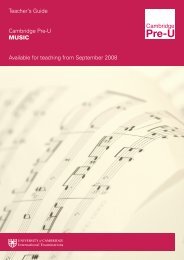Cambridge Pre-U Syllabus - Cambridge International Examinations
Cambridge Pre-U Syllabus - Cambridge International Examinations
Cambridge Pre-U Syllabus - Cambridge International Examinations
Create successful ePaper yourself
Turn your PDF publications into a flip-book with our unique Google optimized e-Paper software.
68<br />
Appendix 4: Performance Descriptors<br />
<strong>Cambridge</strong> <strong>Pre</strong>-U Draft<br />
The following grade descriptions indicate the level of attainment characteristic of the given grade at <strong>Pre</strong>-U.<br />
They give a general indication of the required learning outcomes at each specified grade. The descriptions<br />
should be interpreted in relation to the curriculum content in this syllabus, but are not designed to define that<br />
content. The grade awarded will depend in practice upon the extent to which the candidate has met the<br />
assessment objectives overall. Shortcomings in some aspects of the examination may be balanced by<br />
better performance in others.<br />
Distinction (D2)<br />
Candidates recall and use knowledge of Biology from the whole syllabus with few omissions and show good<br />
understanding of many of the most demanding principles and concepts in the syllabus. They select<br />
appropriate information from which to construct arguments or techniques with which to solve problems.<br />
In the solution of problems, candidates are usually able to bring together fundamental principles from<br />
different content areas of the syllabus and demonstrate a clear understanding of the relationships between<br />
these. Candidates show a broad knowledge and understanding of biology consistent with extensive reading<br />
around and research.<br />
Candidates apply knowledge and biological principles contained within the syllabus in both familiar and<br />
unfamiliar contexts. In questions requiring numerical calculations, candidates demonstrate good<br />
understanding of the underlying relationships between quantities involved and carry out all elements of<br />
extended calculations correctly in situations where little or no guidance is given. They are often successful<br />
on questions which require a combination of applying demanding concepts to unfamiliar contexts, extended<br />
problem-solving and synthesis of ideas from different areas of Biology.<br />
In practical activities, candidates identify a problem, formulate a clear and effective plan using knowledge<br />
and understanding of Biology, and use a range of relevant techniques with care and skill. They are<br />
organised and methodical in the way they carry out their work and present their results. They make and<br />
record measurements which are sufficient and with a precision which is appropriate to the task. They<br />
interpret and explain their results with sound use of biological principles and evaluate critically the reliability<br />
of their methods.<br />
Merit (M2)<br />
Candidates recall and use knowledge of Biology from most parts of the syllabus with some omissions and<br />
show good understanding of many of the principles and concepts within it. They select appropriate<br />
information from which to solve problems, including some problems in unfamiliar contexts. Candidates show<br />
some signs of an ability to bring together fundamental principles from different content areas of the syllabus,<br />
but do not do so consistently. They usually make good use of the concepts and terminology of Biology in<br />
communicating their answers. Candidates show some evidence of knowledge and understanding of Biology<br />
consistent with some reading and research.<br />
Candidates apply knowledge and principles of Biology contained within the syllabus in familiar and some<br />
unfamiliar contexts. In questions requiring numerical calculations, candidates demonstrate some<br />
understanding of the underlying relationships between quantities involved and are usually aware of the<br />
magnitudes of common quantities. Candidates are usually successful in calculations where some structure<br />
is provided and can carry out some elements of extended calculations correctly.

















